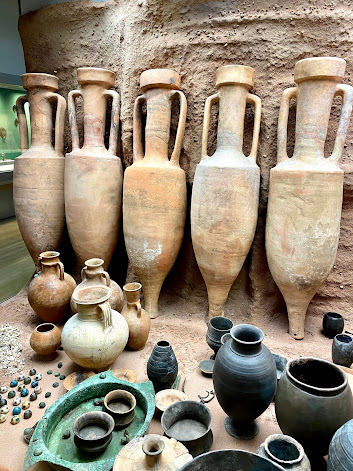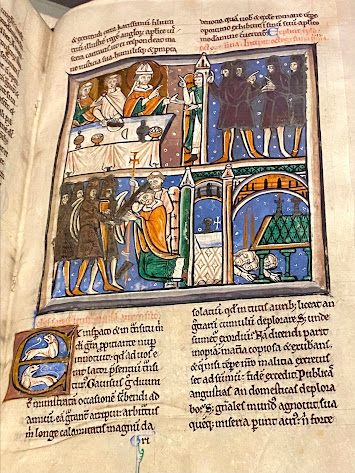Back in January I wrote a list of things I hoped to be able to do this year. One of them was to visit the Thomas Becket Exhibition that the British Museum had planned for this spring. Museums were allowed to reopen on May 17th following the long lockdown and the exhibition opened a few days later, so I decided to hop on a train and go. The British Museum is an easy trip for me, as it is only 15 minutes walk from Euston Station where the trains from our local station terminate, and the train journey only takes about 30 to 40 minutes.

As numbers are restricted to allow for social distancing, I had to book tickets both for the exhibition (paid) and general museum entrance (free). I got there with plenty of time to spare, so sat in Russell Square gardens to eat my lunch and enjoy the sun (at last!), then headed over the museum for my 12.30 entrance slot. There was quite a queue for bag checks, which has been moved to a tent outside the museum, but exhibition ticket holders had a separate entrance with no queue.
I love the Great Court inside the museum, with its cantilevered glass roof and the old British Library Reading Room in the centre. In my postgraduate days the British Library was still within the British Museum and I was able to spend time working in the old Reading Room, which I loved - history just oozed from every corner. The new British library is also a great place to work and far more practical but, well ... new just isn't the same! Still, the Great Court does go some way to making up for the loss of the Reading Room.

I scooted past lots of ancient sculpture (with a slight pause to admire some Ancient Egyptian statues and the Rosetta Stone) as I wanted to spend some time looking at the Anglo-Saxon and prehistoric Europe galleries. Over the past few months I have got interested in prehistoric Britain, about which I previously knew almost nothing, and I am currently reading a new book on Anglo-Saxon England, so wanted to indulge those interests. The photo above is a reconstructed helmet from the Sutton Hoo ship burial, which is now believed to have been the burial mound of Raedwald, king of the East Angles, who died in the early 7th century.

I rather liked these two Anglo-Saxon drinking glasses, also from an early 7th century burial, this time in Buckinghamshire. After the Anglo-Saxons I worked backwards through Iron and Bronze Ages back to Neolithic times. The picture below shows items from an Iron Age grave of the 1st century BC, which have been displayed in the positions they were found.
I think the two axe heads on the left of the picture below were perhaps my favourite items in this gallery. They date from 4000BC and are made from jade quarried in the Italian alps. They were high value, high status ornamental items, too delicate for use as tools, beautifully shaped and highly polished.
I had just the right amount of time to get round the things I wanted to see before my entry time for the Thomas Becket exhibition. When I was a student I took a course on King Henry II with a scholar who was an expert on Becket, so I had quite a bit of background knowledge already. The joy of an exhibition like this is that items are borrowed from many other museums, archives and individuals and can be seen together.
The beautiful casket above is a medieval reliquary, with pictures telling the story of Thomas Becket. Below is the only surviving document with Becket's own seal, on which he calls himself Thomas of London.
There were quite a number of illuminated manuscripts, some telling Becket's story and at least a couple of books that he had owned.
In one section there was a series of replicas of stained glass windows from Canterbury Cathedral showing scenes from miracles said to have taken place at Becket's shrine.
An unexpected treat was an original copy of the 1225 version of Magna Carta, one of only four which survive. The original 1215 version of the Charter didn't "stick" - King John abrogated it soon after it was agreed and had it nullified by the Pope. An amended version was agreed in 1216 after John's death, and this was revised again in 1217 before the final version was agreed in 1225 - so this one is in effect THE Magna Carta.
I could have included a lot more photos, but this post is already rather picture heavy! By the time I had finished looking at the exhibition I was tired from standing mostly still looking at things (why is standing often more tiring than walking?) and was ready to go outside and take off my face mask, so I headed home. On the way back to the station I stopped at a stall for coffee and a vanilla bun and sat in another garden / park area to enjoy a bit more sun. When I got back M had walked down to meet me and we walked back from the station together. After all the pandemic restrictions I now truly appreciate being able to go out and do something like this - something that I would have taken for granted before.












2 comments:
How fantastic! What a blessing to be able to go — and to have the museum there for visiting!
We are very fortunate! Near enough to London to be able to take advantage of what it has to offer, but countryside on our doorstep.
Post a Comment